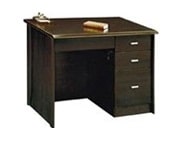MDF is one of the building materials that are used the most often. Medium-density fiberboard is a material that your office furniture provider might talk about a lot. It’s possible that you’ve never heard of it. Simply put, MDF is short for “Medium Density Fiberboard,” which is what the letters stand for.
Because it is cheap, it is a good choice for cladding interior walls, ceilings, cabinets, and even tabletops. It is also simple to use. The materials can be made and used by manufacturers without any trouble. And if you like to remodel offices, it’s easy to fit into a lot of different design plans.
It is made from the fibers of wood. Some people who work in the furniture business might call it “recycled wood.” But it makes sense, because MDF sheets are made from wood fibers or sawdust, which are the raw materials.
During the making process, these raw materials are pressed together to get rid of moisture. It is then cut into smaller pieces and mixed with glue and a chemical component or resin.
The sheets are made by squeezing it together. The sheets are heated and are put under a lot of pressure. The sheets are then made into different shapes by pressing them into molds. Then dried.
The material that will become MDF is sanded after it has dried so that the surface is as smooth as possible. Most panels are covered on the outside with melamine (which can be made of paper or plastic), veneer, or laminate.
This makes the whole thing look better. Most offices would prefer a plain looking tabletop. But some would have their tables to have wood grain finishes.
How many different kinds of MDF are there? There are different kinds and each has its own set of good and bad points. During the making process, changes in the wood, pressure, and temperature can cause these properties to change.
Hollow MDF has a solid core inside that is sandwiched between two layers of veneer when it is made. It is often used in the business world for interior walls, door trim, and paneling. It can be used as a wall instead of paneling to divide a room because it is flexible and doesn’t need to have a stud wall.
Is MDF a suitable material for tabletops? Yes. Most people who work in the office furniture business like to use it. Laminated MDF is the name for this kind of material.
Most cubicles are put together with these types of MDFs. People use them as tabletops or even as walls. Laminate has a unique finish on its surface that makes it look nice and even makes it a good alternative to plywood.
This laminate coating is a protective layer. During work, one of your employees could spill coffee or water on his desk. MDFs don’t really stand up to water. It could easily warp.
Most of the tabletops in cubicles today are made of MDF that has been laminated. Even though it might not be as strong as regular wood, it could last for a very long time.
One of the most important things to think about when using MDF is how much it costs. It costs a lot less than most types of wood. Most BPO offices will try to find ways to lower the cost per cubicle once they have their offices set up. Most of the time, hundreds of people work for these organizations.
Using a less expensive tabletop would have a big effect on their costs. Another way these offices save money is by using regular divider panels in their cubicles instead of metal or laminate ones. They could also save on using regular office chairs.
What are some other reasons why using medium density fiberboard is a good idea? Not only is it easy to work with and cheap to buy, but it is also easy to cut and shape into the shape you want.
Sanding it doesn’t make dust, which cuts down on the amount of work that needs to be done when the project is done. Compared to other kinds of wood boards, this one weighs the least.
You can have paint put on it. It is hard to set on fire. On top of that, neither termites nor rodents can get into it. Since it is made of wood fibers, it is safe to use in places where children are present.
Now you may say this material sounds great. Wait, there are also things you need to know about it. It’s not as durable as hardwood. It doesn’t hold up well in wet conditions. It quickly bents when it gets wet.
Since it is not as strong as wood, it can easily crack. When used a lot, it has a strong tendency to break into pieces.
The density of hardwoods is higher than this material. Wood will last a lot longer. It’s not as easy to fix a scratch in this material as it is in wood. In our experience, it is not possible to reuse the holes that were drilled by the prior screws. You have to drill another hole in the panels.
When there are big changes in temperature, the panels tend to get bigger and smaller. If it isn’t taken care of properly, it can quickly get broken down over time.



